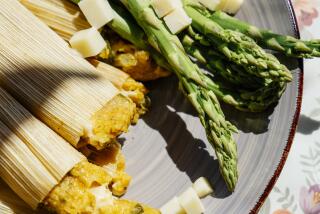Chayote Squash Great as Ornament or Treat
- Share via
The pale-green, pear-shaped chayote squash is one of those unusual vines that serve as both an ornamental and culinary treat.
The chayote has long been a part of the cuisines of Latin America and the Caribbean, to name a couple of the areas where the vegetable is a staple. It is used in much the same way as the familiar zucchini, although the chayote’s crisp flesh is perhaps best savored raw, in salads or with a dip. Scattered plantings around the North County and throughout California allow most supermarkets to keep it in stock during the cool growing season.
For farmers like John Cantabrana of Vista, one chayote vine serves a dual purpose. A single vine climbs over a shed in his back yard, shading a small arbor. Long, curling, tendrils wrap over trellises and poles. Interspersed among the heart-shaped leaves, dozens of deeply-ridged chayote squashes hang like little green Chinese lanterns.
“Just plant a vine next to a fence,” advised Cantabrana, “and it’ll follow it all around.”
With just a little watering, the hardy vine will grow to cover anything in its path, Cantabrana said.
“When I first took them to the market, no one knew what to do with them,” he said, reaching for one of the squashes hanging several feet above his head. One squash can sometimes weigh up to a pound.
The low-maintenance plant need only be completely cut back at the end of the season to reappear full of vigor the next year, Cantabrana said.
Connoisseurs not only savor the squash, but also the edible shoots, the vine’s roots, and even the large edible seed. Thanks to increasing consumer interest in the chayote, Cantabrana finds that his supply barely satisfies the requests of customers at area farmers’ markets. He plans to plant more vines next year.
Keep your ears open when buying chayote squashes from grower Graziano Pena in Vista. Not only will you be rewarded with one of Pena’s trademark bird calls, but also with a list of ways to sample the unusual vegetable. Pena, who grows in Carlsbad and Bonsall, recently opened a stand on East Vista Way. The farmer produces a variety of vegetables and herbs, including tomatillos, kumquats, and even potatoes, in addition to chayotes.
Pena grows his squashes on long trellises, just tall enough for a man to walk under. For him, chayotes taste best when they have been boiled. He then peels off the tough outer skin and cuts the flesh into chunks. “Just sprinkle it with lime juice and ground pepper,” he said.
Irina Gronborg, a botanical artist in Solana Beach, also cites multiple reasons to grow a chayote vine. For several years, a heavy, winding vine covered an arbor on the side of the Gronborgs’ house.
“The only problem was that it ended up in my neighbor’s kitchen,” she said. “It grew so fast.”
The artist appreciates the chayote for its looks, as well as for its flavor.
“It’s a double payoff,” said this expert in drought-tolerant, edible plants. “It’s so beautiful and verdant in spring and summer.”
The plant’s luminous green shade inspired her to reproduce the vegetable in drawings and paintings for a variety of publications. When she first decided to grow a chayote, Gronborg bought one at her local supermarket and simply planted the seed.
“We hardly did anything, we just cut it back in winter,” she said, noting that the plant is resistant to pests. “The best way to grow it is to have it climb on a strong trellis,” she said. Thus, during their first chayote season, the Gronborgs were rewarded with “hundreds” of home-grown squashes.
When she serves the vegetable, Gronborg prefers to use raw, young squashes, and to cut them into their natural, scallop shape. “It’s wonderful when it’s very young. Just serve it with Roquefort dressing.”
Use care in cutting open a chayote because the skin is quite tough. Partially cooking the chayote before stuffing it will make it easier to handle. The large edible seed in the center is considered a delicacy in many parts of the world.
Chayote is also a good source of fiber; it will stay fresh in the vegetable compartment of the refrigerator for up to three weeks.
John Cantabrana, 555 Barsby St., Vista. Sells at area farmers’ markets. Price depends on availability.
Pena Produce, East Vista Way and Ormsby St., Vista. 724-3594. Chayotes in season, 45 cents a pound.
BEST PICK:
Apples are in season. Among other growers at the Vista Farmers’ Market, Lee La Vallee of Le-Ranch in Aguanga, is offering a new crop of Jonathans, McIntosh, and Red Delicious apples, as well as freshly-pressed cider.
More to Read
Eat your way across L.A.
Get our weekly Tasting Notes newsletter for reviews, news and more.
You may occasionally receive promotional content from the Los Angeles Times.









